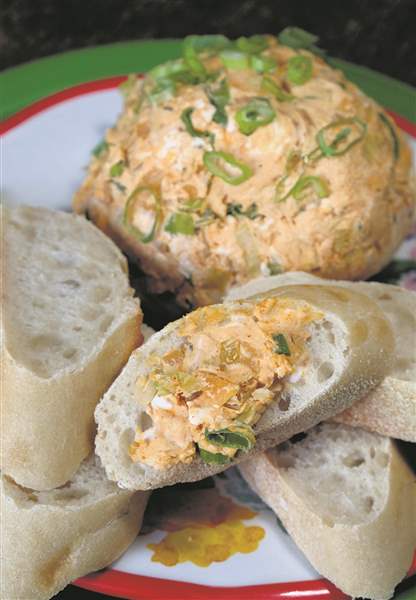
Festivals, pork, and paprika from the heart of Hungary
5/8/2018
Korozott (Paprika Cheese Spread).
THE BLADE/LORI KING
Buy This Image
The City of Festivals welcomes guests to a wide variety of events celebrating culture, food, and wine.
Did you think we were talking about Toledo? That certainly does sound like us.
But it’s actually Szeged, Hungary, which has been one of our sister cities since a formal agreement was signed in October, 1990.
The Rev. Martin Hernady of St. Stephen’s Church and Ann Galloway, then vice-president of TSCI, nurtured the relationship between Toledo and Szeged. Judy Balogh was also integral to cementing this bond, and City Councilman Peter Ujvagi has been deeply involved in maintaining ties with Hungary, where he was born.
The close relationship has even extended beyond our two cities: Lucas County and Csongrad County, where Szeged is located, established a formal commitment in 1996.
“We’ve always been very active,” said Carol LaBounty, who has Hungarian heritage on both sides of her family and whose “mother was 100 percent Hungarian.” She serves as vice president of the Szeged Committee affiliated with Toledo Sister Cities International.
Located in southern Hungary along the Tisza River, near the borders of Serbia and Romania, Szeged experiences all four seasons much as Toledo does, making it particularly well suited to agriculture and to raising farm animals. Therefore, the cuisine is noted for significant use of meats and dairy products, cabbage, and poppy seeds, much like the rest of central Europe.
But Hungary is, of course, most famous for one product in particular: paprika.
“Szeged is really the paprika capital of the world,” said Ms. LaBounty. The pepper plants thrive in the city’s abundance of sunshine.
That spice is featured in a multitude of the city’s favorite foods, beyond just Paprikás Csirke (Chicken Paprikas). It lends it distinctive flavor and gorgeous deep red color to appetizers, stews, stuffed vegetables, and more. It is so valued that it’s celebrated every September at the Szegedi Paprikafesztivál. And Szeged’s paprika — not just the spice in general — is an official Hungarikum, protected and classified as superior.
Pork is preferred in Hungary over beef.
“You didn’t kill the cows,” said Ms. LaBounty. “That was your milk.”
Szeged Wintersalami features this meat. It is also called pick after its creator Mark Pick, who developed his recipe in 1869 after visiting Italy. He felt that prized Hungarian pigs would be particularly well-suited to making variations on sausages he’d tasted on his trip. This version is a cold-smoked, dried blend of pork and secret spices which is so beloved, along with the national pepper, that there is even a Pick Salami and Szeged Paprika Museum for visitors to tour.
“They’re famous, too, for their fish soup,” said Ms. LaBounty. “It’s like gold,” she said of Szegedi Halászlé, which is flavored with paprika and prepared with as many as five different varieties of fish freshly caught from the river. At the end of the summer, the soup is just one of the dishes served and celebrated at the Tisza Fish Festival, which includes a cook-off to find the best version.
Another cherished dish is Székely Gulyás, which translates to Transylvanian stew. Misnamed American-style goulash is a creation featuring macaroni and ground beef. “We call that Yankee Doodle Dandy,” said Ms. LaBounty. Hungarian gulyás, on the other hand, is a hearty pork-and-sauerkraut dish with a soup-like broth that’s flavored with paprika and often enriched with sour cream.
Ms. LaBounty told a story about attending a festival in Szeged one time when gulyás was being served. The stew featured “the mayor’s sheep — he raised them,” she said, before contributing the meat to the celebratory feast.
“Most of their food, they would serve it on a wooden platter,” Ms. LaBounty said, much like fatányéros — an assortment of grilled meats that’s served with fried potatoes. And “they always have some kind of peppers,” she continued. Dill pickles, bread, and sausages such as kolbasz (similar to kielbasa, but with different spices) are often featured, too.
Hungary is noted for sweets such as the elegant Dobos Torte (thin layers of sponge cake with rich chocolate buttercream, topped with caramel), palacsinta (crèpes filled with jam), beigli (sweet breads swirled with poppy seeds or ground walnuts), and krémes (custard cakes topped with puff pastry, which Ms. LaBounty said are “a popular dessert”). But “you’ve got to go to the bakery,” she said. “Not too many people bake at home.”
Almost better than the pastries, though, are the berries in Szeged.
“They’ve got the best strawberries in the world,” Ms. LaBounty said. “They were so good, juicy, big, flavorful.”
Körözött (Paprika Cheese Spread)
8 ounces cream cheese, softened
4 ounces margarine or butter, softened
1 small onion, finely chopped
3 teaspoons paprika paste or 1 teaspoon powdered paprika
½ teaspoon ground caraway seed
1 bunch (6) green onions, chopped
Baguette and/or crackers, for serving
Mix in a bowl the cream cheese, margarine or butter, and onion with the paprika and the caraway until the paprika is evenly distributed.
Mix two-thirds of the green onions lightly into the cream cheese mixture (not to cover the green) and place into a serving bowl. Sprinkle the remaining green onions on the top for decoration.
Serve with crusty bread or crackers to spread the cheese on. Keep refrigerated.
Yield: 4 to 6 servings
Source: Adapted from Elizabeth Balint
Contact Mary Bilyeu at mbilyeu@theblade.com, and follow her at facebook.com/thebladefoodpage, bladefoodpage on Instagram, or @BladeFoodPage on Twitter.